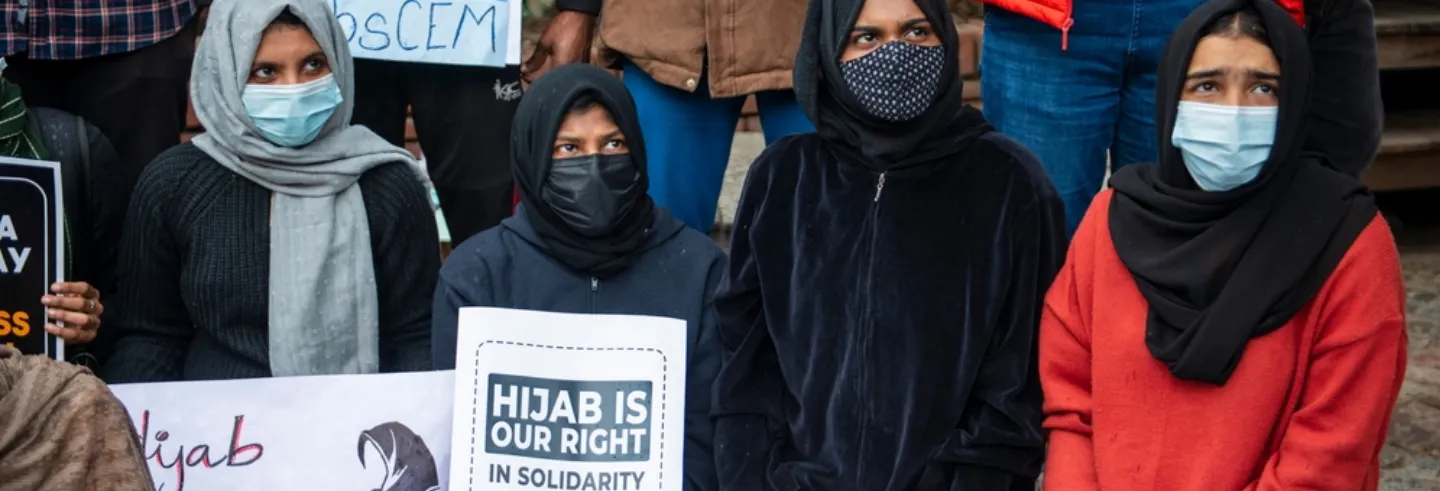Liberal arguments in favour of the hijab hold that though wearing the garment is fundamentally an irrational decision, it is acceptable on grounds of freedom of choice. The central claim is the liberty of clothing and expression.
We argue that rather than mere tolerance on the grounds of choice, the hijab issue and the practice of hijab is a question of dignity and a claim for dignified status by Indian Muslim women.
The issue of the hijab for Indian Muslim women is an issue that requires courage and defiance against even the established liberal feminist concepts. The liberal feminist perspective on the hijab has been from a lens that perceives hijabi women as oppressed and subjugated beings. When liberal feminists claim that wearing the hijab is not a rational decision and is a form of social indoctrination, they altogether negate the dignity of women wearing the hijab. They detach the agency of the practitioners to decide on matters that concern them and impose a set of clauses that must be satisfied to avail the status of ‘liberation’. This comes from the ‘civilisational mission’ of the West and the colonial agenda of treating the East as a subject of experimentation, whose status is dependent on the logic of Western enlightenment rationality, without considering socio-cultural factors in play.
Women in this patriarchal world are deeply discriminated against and subjugated but that lens cannot become our holistic worldview. We need to give agency to the women fighting for themselves. We cannot negate determined acts of Indian Muslim women as mere social indoctrination without asking what social indoctrination is. Humans are not unencumbered selves but need validation from society and function as per their socio-cultural location. There is a need to define cultural activities from a cultural modernist perspective. In this sense, every society has its own approach to modernity.
Muslim women articulate their feelings and concerns by owning their way of life, demanding that the state accept it as normal rather than see it as a choice to be tolerated.
Looked through the lens of practice, the hijab, as a form of ‘modernity of tradition’, is pushing itself to acceptance by transforming itself as a form of liberation by attaching itself to other intersecting marginalities. Indian Muslim women suffer from multiple marginalities, the primary of all is being Muslim. Their gender and religious identity lead to double marginalisation. Muslim women articulate their feelings and concerns by owning their way of life, demanding that the state accept it as normal rather than see it as a choice to be tolerated. Wearing the hijab is a fight against the hegemony of majoritarianism and claiming space for difference, which needs courage in trying times.
We see an incessant attempt to juxtapose Iranian and Indian Muslim feminist struggles. There is a difference between the Iranian women’s struggle against the hijab and Indian Muslim women for wearing the hijab. The former demand freedom and acceptance of choice backed by liberal feminist thinking, but the latter demands more than what the liberal episteme provides. The Iranian feminist movement demands identity and dignity even without wearing the hijab. Theirs is a fight where not wearing the hijab is rebellion.
For Muslim women in India, wearing the hijab makes them doubly vulnerable. They are termed conservative by liberal feminists. They become vulnerable to oppression and rape threats from majoritarian extremists because of their being visibly Muslim. By asserting their autonomy of wearing the hijab and following orthodox Islam, Indian Muslim women counter the narrative of being mazloom – meek and oppressed – and challenge liberal feminist ideas of ‘liberated women’.
In times when being a Muslim is a significant threat on its own […] women wearing the hijab and owning a Muslim identity becomes an act of rebellion and courage.
Indian society is going through a turbulent time where there is shrinking space for differentiated communal living. The targeting of cultural practices associated with the Muslim community signifies deep hatred and malice. The Muslim woman is portrayed by Hindutva groups as an object of lust and desire. Indian Muslim women are aware of their vulnerabilities. In times when being a Muslim is a significant threat on its own, when Muslims fear saying assalam in public, signifying identity overtly calls for courage and determination. Women wearing the hijab and owning a Muslim identity becomes an act of rebellion and courage.
Indian Muslim women stand at a critical juncture, facing oppression from the majoritarian dictates of society and with weak support from the liberal feminists, which at times negates their agency. The ideas and arguments this movement constructs extend the horizons of rationality and acceptability in liberal feminist discourse.
Nafis Haider is a postgraduate student of political science at Jawaharlal Nehru University. Nayab Gauhar works as a lawyer at Socio Legal Information Centre, New Delhi.










